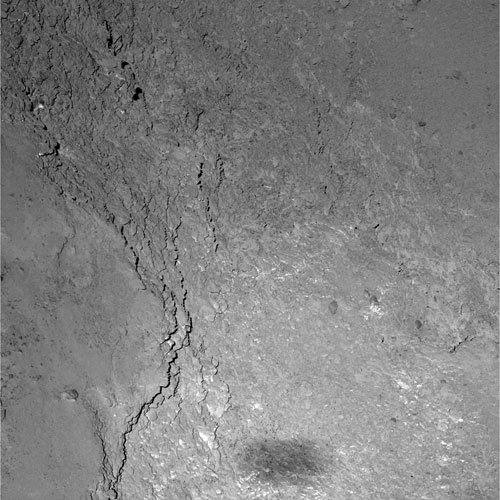
The data were obtained using the high resolution narrow angle camera, the NAC - arrow Angle Camera, - of the OSIRIS (Optical, Spectroscopic, and Infrared Remote Imaging System) instrument. Through its unprecedented resolution of 11 cm per pixel,
the data reveal structural detail on the cometary surface that has never been seen before.
Thanks to the almost ideal alignment of the comet, the Sun and the probe, these quite unique observations are scientifically invaluable, and will lead to a better understanding of the surface properties.
On the lower part of the image can be seen the shadow of Rosetta, and centred on it a huge circular area which is slightly brighter than the rest of the surface. This can understood as a consequence of the well known effect of backscattering by the small particles lying on the cometary surface (this phenomenon has been observed on the Moon, and on other small bodies covered by a layer of finely divided dust particles,
referred to as the regolith).
A study of this backscattering effect will enable one to characterize the properties, such as the grain size, of the cometary dust.
The shadow of Rosetta shows up as a 20m by 50m rectangle. These dimensions correspond to the penumbra of the probe which is illuminated by an extended light source, in effecg by the Sun.
Scientists from the Laboratoire d’études spatiales et d’instrumentation en
astrophysique, the LESIA of the Paris Observatory, are involved in the scientific interpretation of the OSIRIS data, and in particular in the analysis of the photometric properties of the cometary surface.
OSIRIS
The imaging system of OSIRIS was created by a consortium led by the Max Planck Institute for Solar System Research (Germany) together with the CISAS, Padova University (Italy), the Marseille laboratory for astrophysics, the Instituto de Astrofísica de Andalucia (Spain), the CSIC (Spain), the Scientific Support Office of the
European Space Agency (Holland), the Instituto Nacional de Técnica Aeroespacial (Spain), the Universidad Politéchnica de Madrid (Spain), the Department of Physics and Astronomy of Uppsala University (Sweden), and the Institute of Computer and Network Engineering of the TU Braunschweig (Germany).
OSIRIS has the financial support of the DLR (Germany), the CNES, the ASI (Italy), the MEC (Spain), the SNSB (Sweden) and the technical Directorate of ESA.
The NAC, the OSIRIS Narrow Angle Camera
This spatial high resolution imager was conceived and developed by the Marseille Laboratory for Astrophysics (CNRS / Aix-Marseille University) in a partnership with the ASTRIUM society and various European laboratories.
Rosetta
Rosetta is a mission operated jointly by ESA (with the support of its member countirers) and NASA. Rosetta’s Philae lander is furnished by a consortium made up of the ASI, the CNES, the DLR and the MPS.
Rosetta is the first ever mission to rendez-vous with a comet, follow it in its flight towards the Sun, and to deposit a lander on it.
